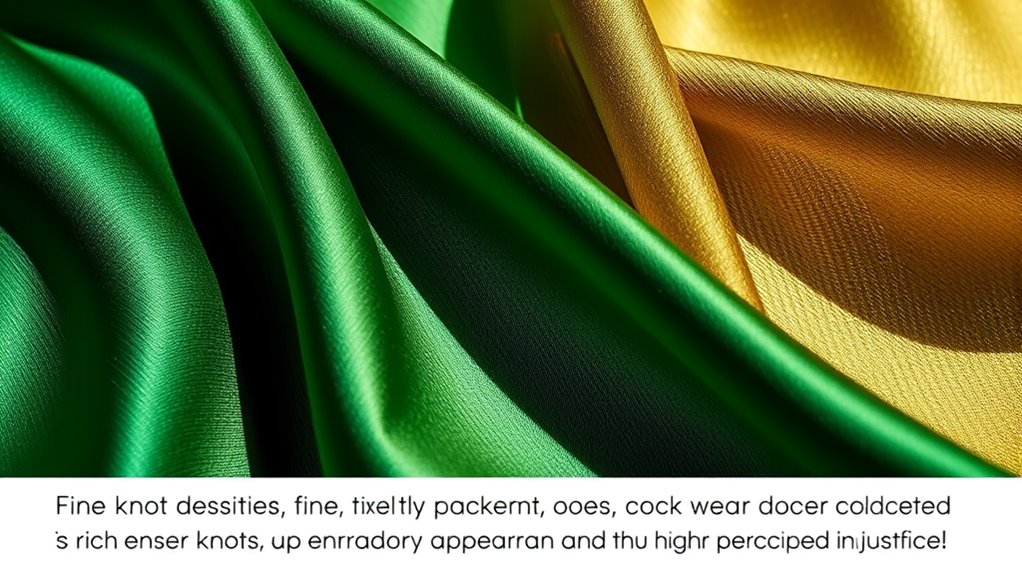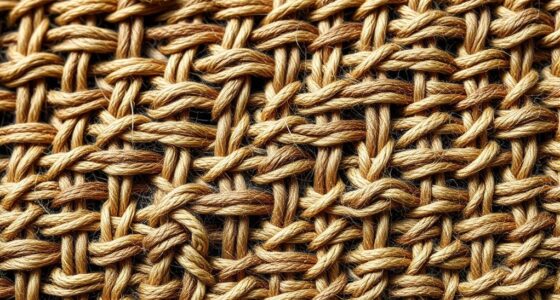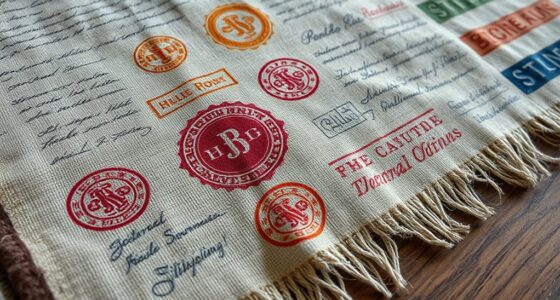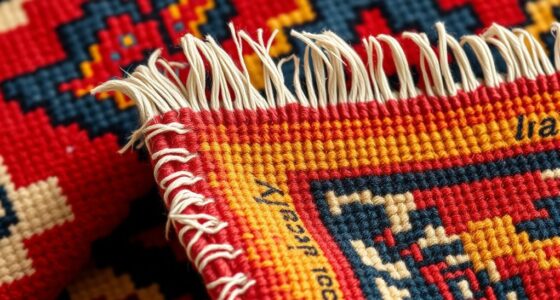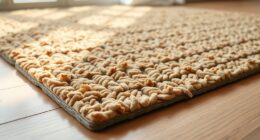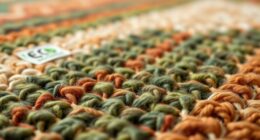Higher knot density generally means a more intricate, detailed carpet, which usually comes with a higher price tag. It indicates better craftsmanship, durability, and visual appeal, making the rug more valuable and long-lasting. However, paying more isn’t always necessary if other factors like material quality or design meet your needs. As you explore further, you’ll discover how to balance knot density with quality and budget for the best investment.
Key Takeaways
- Higher knot density increases rug complexity and craftsmanship, often leading to higher prices due to labor-intensive production.
- Denser knots improve durability and longevity, justifying higher costs for long-term value.
- The price increase may not always equate to better quality if material and craftsmanship are low; assess overall factors.
- Moderate knot density can offer a balance between affordability, durability, and aesthetic detail for practical use.
- Investing in higher knot density rugs is worthwhile if durability and intricate design are priorities, despite the higher upfront cost.
Understanding Knot Density and Its Measurement
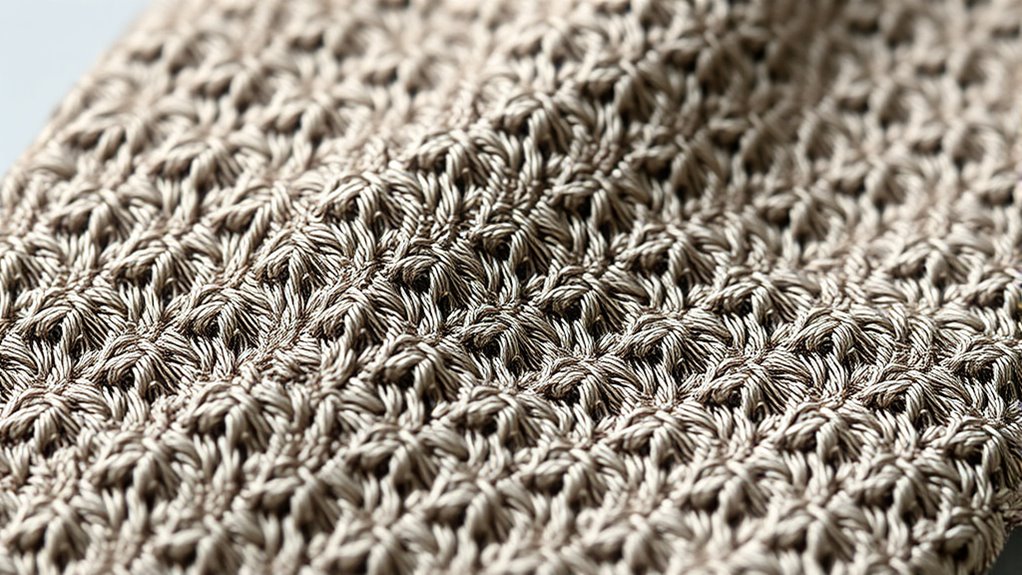
Understanding knot density begins with recognizing how tightly the fibers are woven together in a material. Knot measurement is essential because it quantifies how many knots are tied into a specific area, usually per square inch or centimeter. This measurement directly reflects the rug craftsmanship, indicating the skill and effort involved in creating the piece. Higher knot density means more knots are packed into the same space, resulting in a finer, more detailed rug. When you examine a rug, paying attention to knot measurement helps you gauge its quality and intricacy. Skilled artisans often produce rugs with higher knot density, which can influence both the rug’s appearance and its overall value. Knowing this allows you to better understand what you’re paying for when investing in a handcrafted piece. Additionally, Knot Density can significantly impact the rug’s durability and how well it ages over time.
The Relationship Between Knot Density and Rug Durability
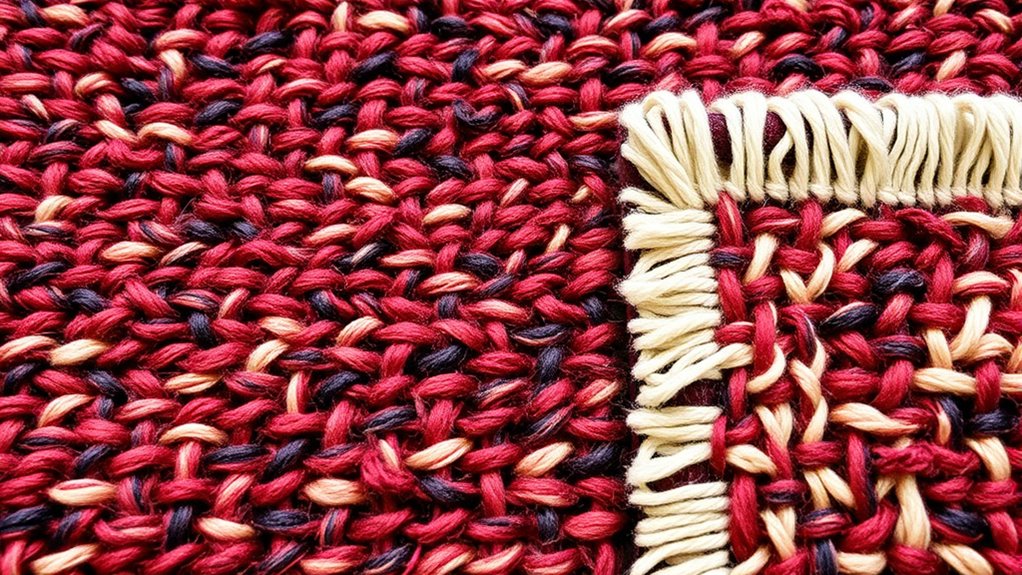
A higher knot density often leads to a more durable rug because the tightly woven fibers create a stronger fabric that can withstand daily wear and tear. However, knot density myths can mislead buyers into thinking more knots always mean better durability. In reality, other factors like material quality and rug construction play significant roles. Rug cleaning techniques also impact longevity; delicate cleaning methods preserve the tightness of the knots and prevent damage. While higher knot density generally enhances durability, it’s not the sole factor—poor craftsmanship or low-quality materials can still result in a fragile rug. So, when evaluating durability, consider knot density alongside overall construction and maintenance practices rather than relying solely on knot count.
How Knot Density Impacts Aesthetics and Design Detail
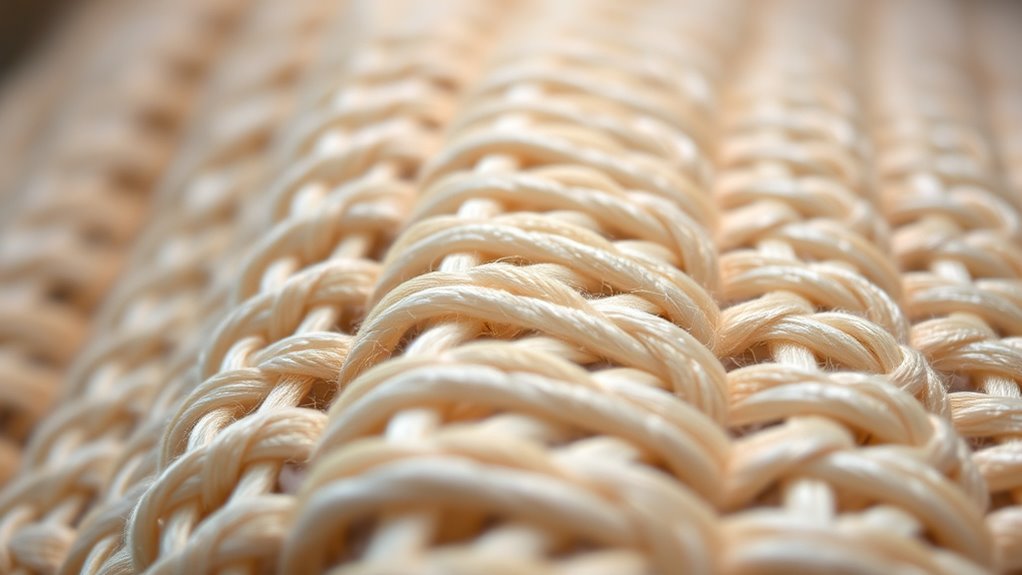
Higher knot density can make your rug look more intricate and visually appealing. It allows for finer pattern details that stand out clearly. As a result, your design becomes more complex and striking to the eye.
Visual Complexity Enhancement
As knot density increases, the visual complexity of woven designs intensifies, adding a richer, more intricate aesthetic that draws the eye. Higher knot density often results in denser fringe styles, creating a fuller, more detailed appearance. This complexity allows for a more vibrant and diverse color palette, as the tighter weave can incorporate subtle color variations and shading. You’ll notice that designs become more dynamic, with added depth and texture that enhance visual interest. With increased knot density, the overall look feels more refined and sophisticated, making the piece stand out. Additionally, understanding the technical aspects of knot density can help in making informed decisions about quality and durability. A higher knot density may also impact the cost of the woven item, reflecting the increased labor and craftsmanship involved in creating a more detailed piece.
Fine Pattern Definition
Increased knot density directly enhances the clarity and sharpness of intricate patterns, allowing even the most delicate details to stand out. Higher knot counts create finer, more precise pattern intricacy, which elevates the overall aesthetic and showcases artistic expression. With a denser knotting technique, designs appear more defined and refined, making every motif and detail more distinguishable. The craftsmanship involved in achieving higher knot density often reflects the skill level of the weaver, adding to the value and uniqueness of the piece. This precision is especially important for complex patterns that rely on subtle variations to convey beauty and craftsmanship. The technique used in higher knot density weaving demands greater skill and patience, contributing to the piece’s exclusivity. As a result, a higher knot density ensures your rug’s patterns are crisp and vivid, capturing the artistic mastery of the weaver. Additionally, color fidelity can be better maintained with increased knot density, further enhancing the visual richness of the design. While this level of detail may come at a higher cost, it considerably improves the visual impact and elegance of the finished piece.
Comparing Cost Differences Between Low and High Knot Density Rugs
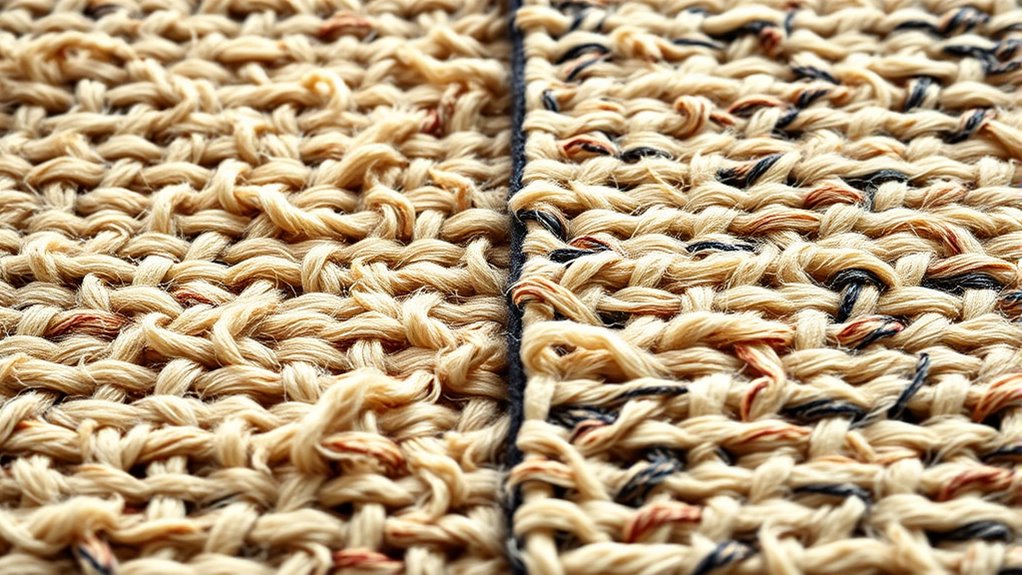
When comparing low and high knot density rugs, you’ll notice significant differences in visual texture and detail, which can affect your overall aesthetic. High knot density rugs often cost more but tend to be more durable and last longer, making them a better investment. Understanding these cost distinctions helps you choose a rug that balances beauty and longevity within your budget.
Visual Texture & Detail
High knot density rugs showcase intricate, detailed patterns that draw the eye and add a sense of depth to the design. The richer visual texture highlights subtle color variations, making each piece unique. With higher knot counts, weaver skill becomes essential, as precision directly impacts the clarity and complexity of the pattern. You’ll notice that low knot density rugs tend to be more uniform, with simpler designs and less detail. In contrast, high knot density rugs reveal a vibrant, textured surface that invites closer inspection. The table below compares visual features:
| Feature | Low Knot Density | High Knot Density |
|---|---|---|
| Pattern Detail | Simple, less precise | Intricate, sharp |
| Color Variations | Limited | Rich, nuanced |
| Texture | Flat | Textured, layered |
| Weaver Skill | Less critical | Essential |
Durability & Longevity
While high knot density rugs showcase exceptional detail and texture, their durability and longevity often set them apart from low knot density options. This is largely due to their material composition and manufacturing techniques. Higher knot counts typically involve more intricate craftsmanship, resulting in tighter weaves that resist wear over time. Quality materials like wool or silk contribute to a rug’s resilience, ensuring it holds up under daily use. In contrast, low knot density rugs may use simpler techniques and sometimes less durable fibers, making them more prone to fraying or fading. Investing in a high knot density rug can mean a longer lifespan, especially if crafted with careful manufacturing techniques. Additionally, artistic influence and cultural significance in rug design can enhance its value and appeal over time. The manufacturing process also plays a crucial role in determining the overall durability of the rug. Proper maintenance practices are essential to preserve its structural integrity and beauty over the years. Moreover, understanding the quality control standards during production can help ensure the rug’s durability and craftsmanship. Ensuring proper installation techniques can also prevent premature wear and maintain its structural integrity longer. Ultimately, paying more upfront can save you money by maintaining its beauty and structural integrity longer.
Factors Other Than Knot Density That Influence Rug Quality and Price
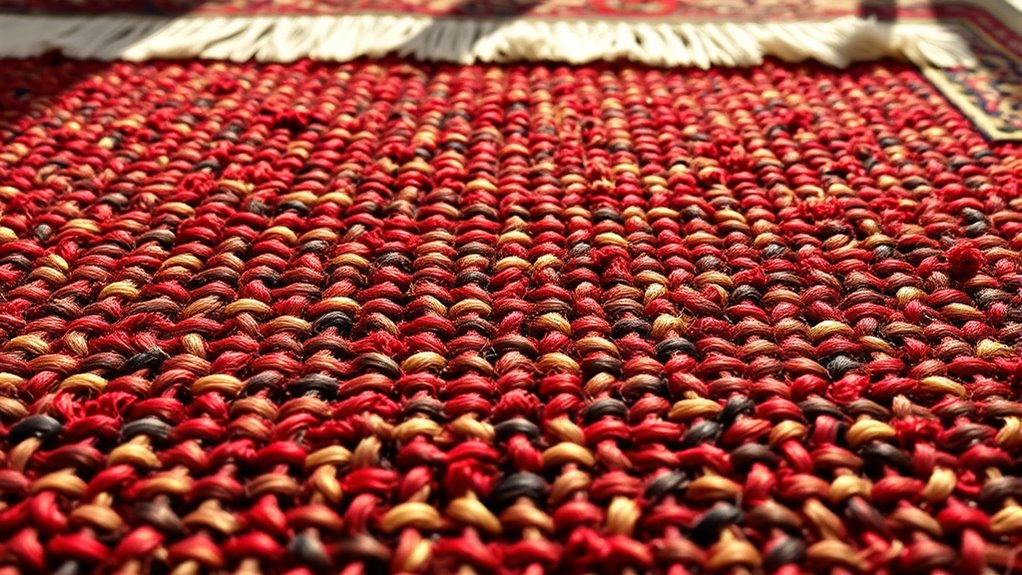
Beyond knot density, several other factors substantially influence a rug’s quality and price. One key aspect is the materials used; synthetic fibers, for example, are common in lower-cost, machine-made rugs. These fibers often result in rugs that are less durable and less luxurious than natural materials like wool or silk. Additionally, the manufacturing process plays a role—hand-knotted rugs tend to be more valuable than machine-made rugs due to craftsmanship and attention to detail. Finishing touches, such as intricate designs and high-quality dyes, also impact value. While knot density affects the rug’s texture, these other factors collectively determine overall quality and price, making it essential to contemplate the entire production process and materials when evaluating a rug’s worth. Furthermore, advancements in AI in Business have improved quality control methods and production efficiency, influencing pricing strategies in the rug industry. Incorporating technology-driven innovations has allowed manufacturers to optimize both quality and cost-effectiveness in their offerings. Additionally, the use of natural dyes can elevate a rug’s aesthetic appeal and value, especially in handcrafted pieces.
Assessing Whether Higher Knot Density Is a Worthwhile Investment
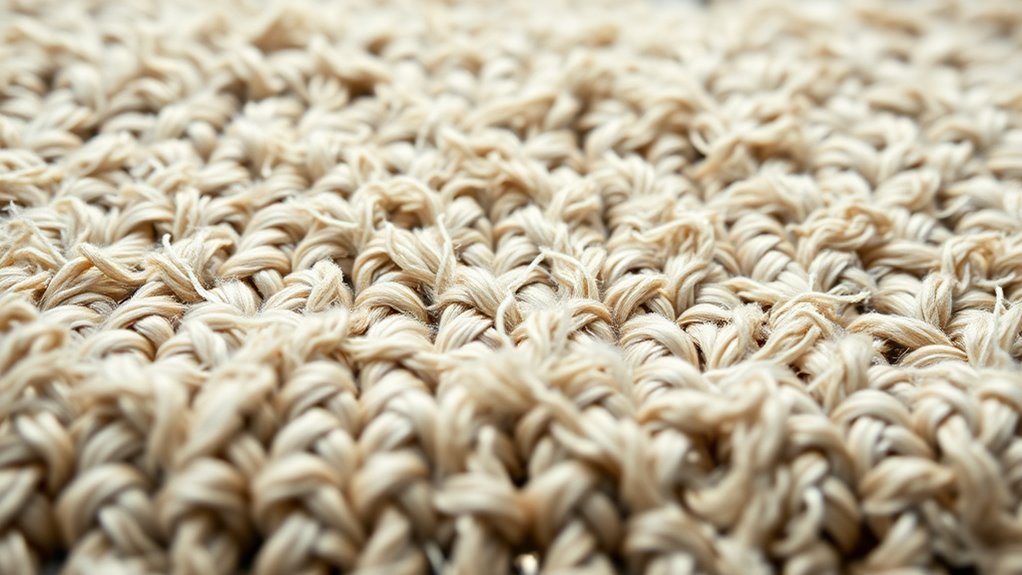
- Longevity and Durability: Denser knots often mean a longer-lasting piece, preserving its value over time. This increased durability can be especially important as automation in business continues to evolve, ensuring the rug maintains its integrity despite heavy use. Additionally, the use of trusted custodians for managing investments reflects a broader emphasis on security and reliability in asset preservation.
- Authenticity and Craftsmanship: A higher knot count can reflect traditional techniques, adding cultural depth.
- Aesthetic Detail: Finer knots allow for intricate patterns that showcase artistry and historical motifs.
- Price Justification: Weigh whether the added cultural and historical value aligns with your investment goals.
Ultimately, determine if the enhanced significance justifies paying more for a denser knot rug.
Tips for Buyers: Choosing the Right Knot Density for Your Needs
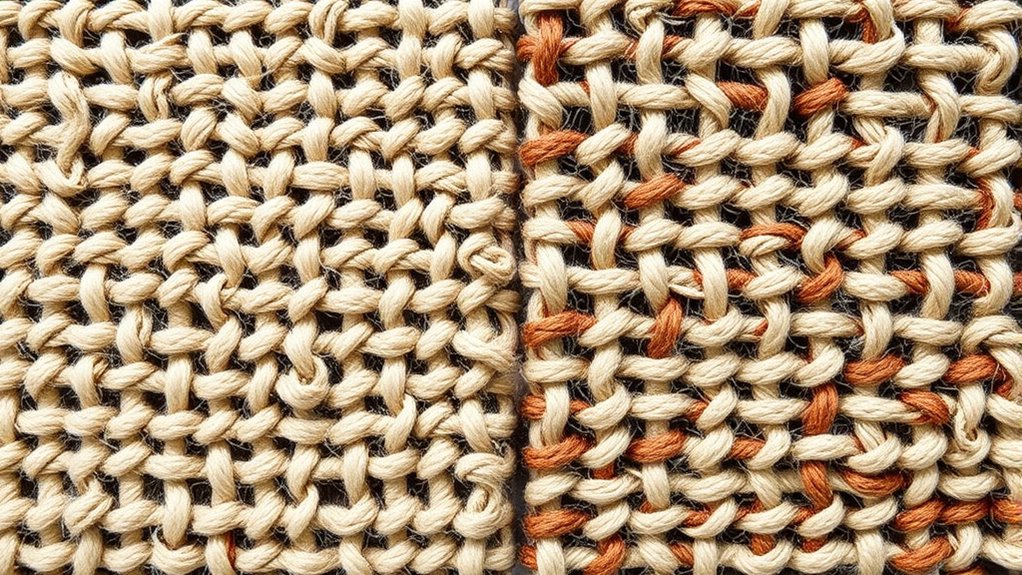
Choosing the right knot density depends on your specific needs and expectations for the rug. Don’t fall for knot density myths that higher counts always mean better quality; sometimes, they just increase cost without added value. Consider your budget and how you’ll use the rug. If you want an affordable rug option for everyday use, a moderate knot density can offer durability without overspending. For decorative pieces or high-traffic areas, a slightly higher knot density might be worthwhile. Think about how close you want to examine the rug’s craftsmanship and how much detail matters to you. Ultimately, selecting the right knot density involves balancing your aesthetic preferences, functional needs, and budget constraints. This way, you avoid paying more for unnecessary features and find a rug that fits your style and wallet.
Frequently Asked Questions
How Does Knot Density Affect Rug Maintenance and Cleaning?
Higher knot density often means a rug has more fibers packed closely together, which can make cleaning more challenging. You might find that it requires more careful maintenance to safeguard fiber durability and prevent damage. While dense knots help preserve color retention over time, they can trap dirt and debris, making regular cleaning essential. Investing in a rug with a balanced knot density ensures easier upkeep while maintaining its vibrant appearance.
Are Higher Knot Densities More Environmentally Sustainable?
Think of knot density benefits like a tightly woven fabric—more knots mean a sturdier rug. Higher knot densities often require more resources, which can increase environmental impact due to longer production times and greater material use. While they produce detailed, durable rugs, their environmental sustainability depends on sourcing and craftsmanship. If eco-friendliness matters most, lower knot densities might be better, but high-density rugs can be sustainable if made responsibly.
Can Knot Density Influence the Rug’S Comfort and Feel?
Knot density definitely influences your rug’s comfort and feel. A higher knot density usually results in a smoother fiber texture and a softer level of touch, making it more pleasant underfoot. On the other hand, lower knot densities might feel coarser and less plush. If comfort is your priority, opting for a rug with a higher knot density can enhance your experience, providing a more luxurious and cozy feel.
Do Cultural or Regional Rugs Typically Have Different Knot Densities?
Regional craftsmanship and cultural symbolism often influence knot densities in rugs. You’ll find that rugs from regions with rich traditions, like Persia or the Caucasus, tend to have higher knot densities, showcasing intricate designs and skilled artistry. These regional differences reflect cultural values and craftsmanship, making each rug unique. If you value detailed patterns and cultural significance, paying attention to knot density can enhance your appreciation and choice.
How Does Knot Density Impact the Rug’s Ability to Resist Stains?
Knot density directly impacts a rug’s stain resistance because higher knot density creates a tighter weave, making it harder for spills and dirt to penetrate. When you choose a rug with increased knot density, you’re getting better durability against stains and easier cleaning. So, if stain resistance matters to you, investing in a rug with higher knot density is worth considering, especially in high-traffic or spill-prone areas.
Conclusion
Ultimately, choosing the right knot density is like finding the perfect melody—balance is key. While higher density rugs often boast durability and detail, they come at a higher price. But remember, more isn’t always better if it doesn’t suit your needs or budget. By understanding what matters most to you, you can make a smart choice that sings in harmony with your space—and your wallet. After all, quality is worth the tune you pay for.
